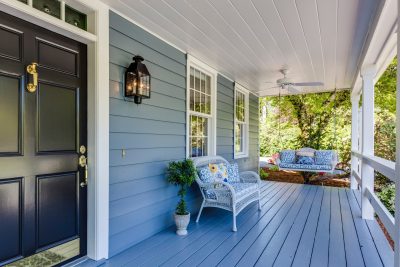You may have heard that you should have a mix of stocks and bonds in your portfolio to reduce risks. An economist that teaches at a top university on the West Coast tipped us off to a different approach. In this approach, you use real estate, instead of bonds, to reduce the risk of heavy swings in the stock market. Let us explain why.
How Stocks and Bonds Are Related
A rule of thumb is that the value of both stocks and bonds rises and falls together. However, there are situations where this breaks down. Under these circumstances, stocks and bonds will move in opposite directions.
When you see bonds fall but stocks rise, it is a likely indication that the economy is doing well or beginning to improve. As profits increase, stock prices usually increase. However, this leads to higher inflation. The inflation is kept in check by the Federal Reserve raising interest rates. Because bond prices are tied to interest rates, rising rates makes it more expensive for companies to borrow money. These new bonds push down the rates of existing bonds causing the bond market as a whole to go down.
When you see stocks fall but bonds rise, it is often an indication that the economy isn’t doing well. As people become worried about the economy, they will pull their money out of stocks, causing stock prices to go down. To seek a safe haven for their money, people start buying bonds – which are seen as a more stable asset. This leads to drops in the interest rates as bond prices increase. Interest rates can also be artificially lowered by the Federal Reserve – which leads to rising bond prices.
Balancing High and Low Volatility Assets
To reduce risk, general wisdom says you should have a healthy mix of stocks and bonds. Also, as the market changes, you should adjust the concentrations in this mix up or down to get the perfect balance between stocks, bonds, and the market.
This general wisdom is driven by solid reasoning. When you have high volatility (risky) assets like stocks, you need to balance them with low volatility assets. By doing this, you dampen the damage caused when the risky assets are hit hard by changes in the market. Most people choose to hold bonds as the low volatility asset.
A Better Way
There are several problems with using bonds to counter balance stocks. First, bonds have been producing low returns year after year. Bonds had their heyday in the late 1970s and early 1980s but have been in decline since.
Bonds have an inverse relationship between yield and value. As the yields from a bond trend downward, you have to pay more for the bond – even though the yields are lower. Unfortunately, the higher the price of a bond, the lower the yield. Conversely, as the yields rise, the investor will suffer a loss of principal. Thomas Kenny, from The Balance, explains the basics of bonds well in his article Why Bond Prices and Yields Move in Opposite Directions.
We feel there is a better way.
…the reality is that investment portfolios focused on the “Big Two Traditionals,” bonds and equities (stocks), are forcing investors to compromise – either by sacrificing return for lower volatility or enhancing return at the expense of higher risk. Real estate may offer a way out. This is why we believe real estate is increasingly being viewed, not as an alternative, but as an essential portfolio component.
REAL ESTATE: ALTERNATIVE NO MORE, J.P. MORGAN ASSET MANAGEMENT
When you invest in apartments, you get higher stability like bonds. This is partly due to the longer market cycles of real estate. It is also driven by demographics which help keep housing demand high. Aside from that, apartments have had historically better returns than stocks. In other words, you get stability and higher returns making it a win-win.
You also don’t have the troublesome inverse relationship of bonds. When you increase the yields of an apartment, instead of values going down, you get a multiplying effect. So by increasing yields you also increase the value of the apartment.
If you aren’t including real estate as part of your portfolio, it may be time for a change. Contact us today to get started.
The laws and regulations for rental properties are constantly changing. Each state, county, and city can have their own rules for the handling of security deposits, the ability to increase rents, the warranty of habitability, how evictions are handled, etc.
At Master Multifamily, we look to invest in states that are considered landlord-friendly. This can reduce risk to our investors and make for easier property management. This is only one of many things we consider when choosing where to invest.
While we look for landlord-friendly states, we also want to provide a safe and affordable place for people to live. The following map from RENTCafé shows which states are renter-friendly and which are landlord-friendly.
Real estate provides many different options for investors. We are always amazed, and sometimes perplexed, by the many ways people invest in real estate.
Every method has its set of positive and negative aspects. We would like you to be aware of the most common options out there. Above all, we want you to understand why we like apartments so much.
Single Family Residences (also known as SFR)
When people think of real estate investing, buying a house to live in is usually what comes to mind. They make up the neighborhoods throughout most of America. Many people buy a house and consider it their largest investment. However, single family homes should be lived in, not invested in.
It is common to think that a house is an investment when, more often than not, they are a liability. Houses have become a way for banks to make money and come with risks and expenses that have to be paid for by the owner.
Homeownership is not a way to build wealth. It may be a place to save money – not make money
CNBC Study
When you consider upkeep, insurance, property taxes, roof repairs, heating and cooling repairs, real estate fees, landscaping, etc. a single-family home is a terrible investment.
Flipping or Wholesaling
Flipping has become a craze seen on many reality TV shows. It involves taking a single-family home, fixing it up, and then reselling the property either before or after the closing. What most people don’t realize is that this isn’t real estate investing. Flipping is speculating and usually turns out to be more of a job.
One family member decided to flip homes in their spare time. They started right before the real estate bubble burst in 2008/2009. Having many projects in the works, they were left holding onto properties that could not sell. Luckily they were able to turn the properties into rentals but they were left with many years of unanticipated problems.
Wholesaling is pretty much flipping a property but usually doesn’t involve any improvements. The wholesaler will get a property under contract and then sell the contract to a buyer or another investor.
Ultimately flippers and wholesalers discover that it is better to own the properties than to flip them. They will usually flip a few homes and then want out of flipping because of the amount of work involved with only short-term gains.
Single-Family Home Rentals
Owning single-family homes and renting them out is what most people think of when investing in real estate. It is a common misconception that you have to start buying single-family homes and then somehow graduate into larger properties.
One big problem with single-family homes is that they are either 100% rented or 100% vacant. When a tenant leaves and destroys the place, there aren’t other renters paying to help cover the expenses.
Single-family homes don’t scale like multi-family investments. The investor has to buy one at a time, run around town maintaining houses everywhere, or hire someone to manage them. When they want to sell the properties, they have to close on each one individually.
Duplexes, Triplexes, & Fourplexes
Within any given city, rentals with one to four units are the most common multifamily properties. Anything less than five units isn’t considered commercial real estate.
These properties are easier to find and low priced. At times, people that buy these rentals plan on living in one of the units and renting out the others.
While you can buy these properties with less money, they often require more time and effort to maintain. They can produce very little income and come with some of the same problems as single-family rentals.
Many people start here because they can be easier to find and finance. However, when the economy takes a dive, non-commercial real estate is usually the first to be lost to foreclosure. This is because the properties tend to not produce enough income to support the expenses – especially when rents have to be reduced and it becomes harder to improve the property.
Commercial Rental Properties (5+ units)
Properties with five or more units are considered commercial real estate. The larger they get the more they scale. Once they are large enough (around 60 units) they are able to have their own on-site staff, including maintenance.
Commercial real estate can be anywhere from 5 units to more than a 1,000. With more doors, it becomes easier to make money and weather economic downturns. This is due to the economies of scale and efficiencies you gain.
Unlike smaller properties, commercial real estate is valued based on the money left over after expenses. This left over money is known as the Net Operating Income (NOI). The better you operate the property by reducing expenses or increasing income, the higher the value.
Other Types of Commercial Real Estate
Retail Properties
Retail real estate includes stores, malls, and other shopping centers. The owners of this real estate rent out the space to other businesses. These businesses can include restaurants, clothing stores, law offices, thrift stores, home goods, grocery, etc. The success of retail properties is closely tied to the economy, location, and businesses leasing the space.
Triple Net Leases
Most of the big retail businesses, fast food chains, large pharmacies, and other franchises don’t actually own the real estate their businesses are built on. They prefer not to own the real estate and will instead rent it. However, they will want to build out the property to suit their needs.
These businesses take care of the maintenance, taxes, insurance, and other expenses associated with the property but don’t own the real estate. Instead they pay rent to the owner according to the lease. These are known as Triple Net Leases (NNN) with the three parts being taxes, insurance, and maintenance.
These properties suffer from the same risks as the retail properties. They can also be affected by changing technologies and societal shifts.
Office Buildings
Office space can be rented out to either a single tenant or multiple tenants. In this case, the business prefers to rent the space instead of own real estate. The tenants usually sign for longer leases (7-10+ years). At the start of the lease, there can be large capital expenses associated with making the space ready for the tenant.
Let’s face it, we want to be financially secure. We may want a larger home. We may want to send our children to the best colleges. Many of us have dreams of comfortable retirement years spent traveling around the world. Reaching such goals will take money. Yet, we probably don’t relish the idea of giving up more of our precious time to reach those goals.
So how can you build your financial wealth to meet your life goals? How can you secure a better lifestyle without being forced to work even harder? Answer: Invest passively in multifamily real estate
Over the years passive investments in apartments have proven themselves to be wealth building engines. The wealth comes from:
- The “value add” strategy,
- Increasing the velocity of your money, and
- Tax efficient gain harvesting
What is the “Value Add” Strategy?
A Value-add Strategyi increases multifamily real estate values by raising rents, reducing vacancy, and reducing expenses to increase net operating income (NOI). To capture value, apartment complexes are rehabbed in a process sometimes called “flipping” apartment buildings.
How can I increase the velocity of my money?
The value add strategy’s wealth building power can be magnified if you increase the velocity of the movement of your money (i.e. reduce the time it takes to compound your investment returns). We call this the velocity principle.
Understanding the Velocity Principle: The Rule of 72
Background: The Rule of 72 is a commonly understood financial formula that quantifies how long it takes to double your money at a given a rate of return. For example, if you divide 72 by 6 percent, the rule states that it will take 12 years to double your money at a constant 6 percent rate of return.
Cascading Your Wealth Upward: The velocity of your money, or the speed at which value doubles, is critical to rapid wealth creation. We call reducing this time as “cascading your wealth upward.”
At Master Multifamily LLC we seek to double your money over five to six years. In other words, we seek to harvest annual investment returns of between 12 and 15 percent . At the same time, we seek to distribute annual cash returns of between 5 and 7 percent to you. These are our goals, not guarantees.
A wealth building example: Let’s look at an example of the application of the Rule of 72. Say a person has $1 million to invest in apartment buildings. After careful consideration, they decide to do so. Let’s assume they receive a cash-on-cash rate of return of 5 percent. This means that they would receive a (tax shielded) cash distribution return of about $50,000 per year. Let’s also assume that the investment principle amount doubles within five years, and the funds are reinvested in apartment buildings at the end of year 5.
In this scenario, the annual cash distribution return would increase to $100,000 after 5 years, while the principal amount invested would increase to $2 million. Assuming this process is repeated after another 5 years (10 years total), the principal invested grows to $4 million, and the cash distributions would increase to $200,000.
While an investor may not be able to live on $50,000 of tax shielded income at the beginning of the investment process, receiving $200,000 per year after 10 years could provide financial independence. Note: True wealth is best measured by the amount of your reliable spendable income.
How can I ensure wealth building continues?
To continue growing value, harvesting gains in a tax efficient manner is critical. Once the “value add strategy” has worked its magic, your investment should be moved to a different asset so value compounding can continue.
Tax Efficient Gain Harvesting – Three Strategies
- Debt Refinance – This strategy may return all, or a large portion of, the amount invested by you while at the same time preserving cash distributions from the property. No taxes are due because of a refinancing transaction.
The refinancing proceeds can be placed in a new investment, thereby providing a new opportunity to capture value compounding. - Section 1031 Exchange – Once the expected growth in the value of an apartment complex has been realized, the sponsor can sell the property and redeploy the proceeds into a larger asset or multiple assets via a Section 1031 Exchange.The Section 1031 Exchange feature of the tax law is only available for real estate assets. It permits you to defer payment of capital gains taxes. An exchange would not return principal immediately to you; however, the exchange would provide you with higher cash distributions and an opportunity to accelerate principal appreciation.
- Sale Only – A project sponsor may decide to sell an apartment complex when market conditions present an opportunity to harvest gains. A sale will usually result in payment of capital gains taxes by you when the increase in value is distributed. As such, a sale could partly interrupt the compounding of your investment value due to the tax obligation that must be satisfied. An individual investor, however, may seek to redeploy their investment by completing their own Section 1031 exchange.
You can work with the sponsor of your multifamily investment partnership to encourage an exit strategy that best reflects your goals. By applying these strategies and principles, each dollar invested will be put to hard work in accomplishing your goals and thereby improving your life.
Real estate can be valued or appraised using three different methods:
1. The Cost Approach – The cost to replace or reproduce the improvements plus land cost. This method is typically used for valuing new construction.
2. The Sales Comparison Approach – Comparison of other recently sold properties that are comparable in size, quality, and location to the subject property.
3. The Income Approach – An objective estimate of what a prudent investor would pay for the property based upon the net operating income the property produces.
The Income Approach is used most in estimating the value of multi-family real estate investments because they are income-producing assets owned by investors seeking financial returns on their investments.
The Income Approach is driven by the formula:
V = NOI ÷ iV = Value
NOI = Net Operating Income
i = Capitalization Rate or “Cap Rate” (Return on Investment)
Net Operating Income (NOI) is the net income (before mortgage payments) derived from operating the property.
It is important to note that Annual Debt Service (Principle and Interest) is not an operating expense. It is a debt or financial expense paid from the property’s net operating income. Depending upon an investor’s risk tolerance level, properties can have varying levels of debt – or no debt at all. (Depreciation expense is also not an operating expense, and the same is true of a capital replacement allowance.)
The Capitalization Rate or “Cap Rate” is the percent annual return given a specific investment or property value. It is the net operating income of the property divided by its value. Technically, it is the weighted average cost of capital, both debt and equity, invested in an income producing asset. (However, market expected Cap Rates affect values in competitive markets.)
Knowing any two of the three components of the formula V = NOI ÷ i will allow you to solve for the third. Following are variations of the formula:
NOI = Value x i
i = NOI ÷ Value
V = NOI ÷ i
Source: A Real Estate Investor’s Guide To Valuing Multi-Family Real Estate Using Cap Rates By: Dennis J. Noneman, CCIM
As you consider how real estate investing may help you to reduce or defer your income taxes, please consult your legal and tax advisors about your own situation. Tax advice should be customized. (The comments provided here do not constitute specific legal or tax advice.)
The United States income tax laws and regulations contain provisions that are beneficial to real estate investors. The most important and common aspects of these rules are as follows:
1. The Potential for Non-cash Losses to Offset Ordinary Income
For investors with adjusted gross incomes (AGI) of up to $150,000, operating losses from real estate caused by favorable depreciation rules may allow a full or partial deduction of up to $25,000 in real estate losses annually against ordinary income. This benefit phases out as AGI levels exceed $100,000 annually. This is one scenario where it may be possible to have cash flow positive real estate investment results, while also potentially reduce ordinary income taxes. Your specific result will depend on the annual facts pertinent to your income sources and portfolio.
For high income investors, real estate non-cash losses may be required to be suspended and deferred until the time of a taxable sale of the real estate investment. This is a feature of the IRS Code’s passive activity rules. However, this should be understood as favorable tax treatment since the investor may receive positive cash flows while paying no income tax (due to the depreciation deductions). The deferred real estate income treatment is similar to the deferral of taxation on cash returns within an IRA; however, in this case the investor may both receive and spend cash without paying current income taxes. Compare this to dividends and interest paid by most other investments (i.e. stocks and bonds), which are taxable to the extent of the cash received by the investor.
If you actively work in real estate businesses, you might qualify as a Real Estate Professional (REP). REPs must work actively at least 750 hours per year in real estate businesses, and more in real estate than in any other business, among other requirements. For such investors, they may offset real estate losses against ordinary income when calculating their tax liability, regardless of how large their AGI is in the year. The REP test must be met each year to qualify for this benefit, but only one spouse needs to qualify.
2. Favorable Depreciation Rules
Real estate investors in residential housing may deduct the costs of housing assets, except for the cost of land, over 27.5 years, or a shorter life. Buildings are depreciated over 27.5 years. Short-life equipment may be deducted over 5 years, while other types of real estate asset components have other depreciable lives. To maximize depreciation deductions (and tax deferrals or reductions), investors may perform a cost segregation study to identify the component assets of each investment.
3. Tax Rate Benefits
When an investment in residential property ultimately is sold, investors are generally taxed at a capital gains tax rate for the portion of the gain that exceeds their original cost. Additionally, the depreciation which was taken during the life of an asset is generally taxed on sale at a tax rate (28%) between ordinary tax rates and the capital gain tax rates. Deferred real estate losses are recognized at the time of the sale and serve to reduce these taxable gains.
4. Other Tax Deferral or non-Recognition Benefits
Real estate investors who sell properties, but who also meet complex like-kind exchange rules under Section 1031 of the Internal Revenue Code, may defer recognition of all or portions of their gains. This means that investors can redeploy profits into larger, or more profitable, investments while not paying taxes on the intermediary transactions. The successful completion of these transactions requires competent transaction facilitators, intermediaries and professional advice. The “tax basis” of the old property is transferred to the new property so the gain on the exchange sale is deferred into the future.
This exchange strategy is limited to structures where a fund does the 1031 Exchange or ownership structures where the investor has direct title in the asset. A limited partner or LLC member cannot trade the proceeds from a sales distribution from a real estate partnership or LLC under these rules.
Real estate properties may be refinanced in “cash out” transactions with no recognition of tax on the cash proceeds since a refinance is not a “sale” event under the Internal Revenue Code. Second mortgages used to finance real estate investments create tax deductible interest expense (as long as the aggregate proceeds are $100,000 or less).
Investors who leave their heirs real estate may permanently create non-recognition of inherent gains in the properties because the tax basis is “stepped-up” to fair value at the time of death. Furthermore, the heirs can depreciate the real estate assets based on the stepped-up basis.
Investing in real estate ventures through LLCs and limited partnerships presents gifting and estate tax benefits. Unlike stocks, when an investor gives an LLC interest of a real estate investment to a family member, an investor will likely be able to reduce the value of the gift by about 30% for gift and estate tax rules. The value is discounted under the theory that the investor has limited control over the LLC interest under IRS rules.
Gains from the sale of a taxpayer’s primary personal residence are excluded from capital gains taxation of up to $500,000 for married couples and $250,000 for single individuals if the taxpayer has lived in the home for two of the last five years. In addition, should the gains from the sale of a taxpayer’s primary residence be greater than those exclusions, the taxpayer may also invest that portion through a 1031 exchange. (See http://www.investopedia.com/articles/tax/08/real-estate-reduce-tax.asp).
The investor’s home may be a strong engine of personal wealth creation in markets where home prices are appreciating since such non-taxable gains may be invested in another home or into other investments.
5. Business Tax Deductions
Real estate investors may create favorable business structures to facilitate liability protection while creating tax-advantaged reporting structures. These business structures include partnerships, C and S corporations and LLCs. (Note: it is not recommended to hold real estate investments in corporations.)
As a part of these activities, real estate investors may create business enterprises and conduct business in a way that seeks to maximize available tax deductions. Yes, investing in real estate may be structured as a business! Just a few of the types of ordinary and necessary business deductions that may be available include the home office deduction, employing a spouse or children, meals and entertainment, vehicle deductions, travel expenses, office expenses, small capital improvement deductions and telephone expenses. Following the IRS rules for deductibility of each type of cost can result in increasing business deductions while offsetting some otherwise personal expenses. In addition, using the appropriate tax structure may reduce the marginal tax rates paid on the investor’s income.
6. Other Tax Points
Real estate investing income is generally not subject to self-employment tax (FICA and Medicare) unless you are conducting an “active” real estate business. Active real estate businesses include activities such as real estate sales and brokerages, flipping houses, real estate construction and development, renting hotel space or short-term trading of properties. Consideration should be given in some of these activities to takes steps to avoid the “active” business label.
Perhaps the most discussed trend in commercial real estate in recent years has been the Millennials, the age cohort who are changing work and living arrangements across the nation. A relatively less covered demographic trend of greater size and perhaps importance is the aging population. According to data from the U.S. Census Bureau and analyses by the Lakemont Group, the overall population in the United States is forecast to grow by 11.55% in the next 15 years while the population above the age of 75 is forecast to grow 69.21%. In fact, those over 75 years old will represent almost 10% of the population by 2030 (those above 65 will be over 20% as well).
While many real estate market participants correctly use these statistics to justify the need for more senior housing, there are actually many other real estate opportunities to service this growing segment of the population. Market rate apartments with features and locations this demographic wants, can use, and can afford is one such example. Properties to house medical services and activity retail is another.
We encourage investors to think long-term when making acquisition, disposition, and asset management decisions. This is one long-term trend that could shape demand for many property types for decades into the future.
Are We In a Commercial Real Estate Bubble?
The most meaningful indicator of a potential bubble or overpricing of commercial real estate is the spread between cap rates and underlying treasury rates. According to RCA, cap rates averaged 6.5% nationwide during 2015, while the 10-year treasury rate averaged in the low 2% range for most of 2015 and early 2016.
This implies a spread of over 4% (or 400 basis points). Today’s spreads are significantly higher than those observed pre-crash where they averaged slightly below 200 basis points and even below 100 basis points for class A assets in top markets according to the commercial real estate economics researchers at the Lakemont Group.
In summary, the market is not presenting the same risk/return profile observed before the 2007 peak of pricing. Further, debt availability is far more constrained post crisis with total leverage utilization down significantly (in fact, the percentage of all equity transactions in many markets is staggering) and therefore the risk of default is relatively low for most investors and deals. Thus, we believe pricing in commercial real estate markets does not represent a new bubble or other significant source of risk.







